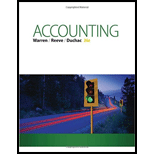
Concept explainers
Accounting for materials costs
In papermaking operations for companies such as International Paper Company, wet pulp is fed into paper machines, which press and dry pulp into a continuous sheet of paper. The paper is formed at very high speeds (60 mph). Once the paper is formed, the paper is rolled onto a reel at the hack end of the paper machine. One of the characteristics of papermaking is the creation of “broke" paper. Broke is paper that fails to satisfy quality standards and is therefore rejected for final shipment to customers. Broke is recycled hack to the beginning of the process by combining the recycled paper with virgin (new) pulp material. The combination of virgin pulp and recycled broke is sent to the paper machine for papermaking. Broke is fed into this recycle process continuously from all over the facility.
In this industry, it is typical to charge the papermaking operation with the cost of direct materials, which is a mixture of virgin materials and broke. Broke has a much lower cost than does virgin pulp. Therefore, the more broke in the mixture, the lower the average cost of direct materials to the department. Papermaking managers frequently comment on the importance of broke for keeping their direct materials costs down
a. How do you react to this accounting procedure?
b. What “hidden costs” are not considered when accounting for broke as described?
Trending nowThis is a popular solution!

Chapter 20 Solutions
ACCOUNTING-W/CENGAGENOWV2 ACCESS
- Solve this Accounting problemarrow_forwardTutor please provide answerarrow_forwardThe Sakamoto Manufacturing company's Finishing Department started the month with 18,200 units in its beginning Work in Process (WIP) inventory. An additional 275,800 units were transferred in from the prior department during the month to begin processing in the Finishing Department. At the end of the month, there were 39,600 units in the ending Work in Process inventory of the Finishing Department. How many units were transferred to the next processing department during the month? Please helparrow_forward
 Managerial AccountingAccountingISBN:9781337912020Author:Carl Warren, Ph.d. Cma William B. TaylerPublisher:South-Western College Pub
Managerial AccountingAccountingISBN:9781337912020Author:Carl Warren, Ph.d. Cma William B. TaylerPublisher:South-Western College Pub Financial And Managerial AccountingAccountingISBN:9781337902663Author:WARREN, Carl S.Publisher:Cengage Learning,
Financial And Managerial AccountingAccountingISBN:9781337902663Author:WARREN, Carl S.Publisher:Cengage Learning, Principles of Cost AccountingAccountingISBN:9781305087408Author:Edward J. Vanderbeck, Maria R. MitchellPublisher:Cengage Learning
Principles of Cost AccountingAccountingISBN:9781305087408Author:Edward J. Vanderbeck, Maria R. MitchellPublisher:Cengage Learning Cornerstones of Cost Management (Cornerstones Ser...AccountingISBN:9781305970663Author:Don R. Hansen, Maryanne M. MowenPublisher:Cengage LearningPrinciples of Accounting Volume 2AccountingISBN:9781947172609Author:OpenStaxPublisher:OpenStax College
Cornerstones of Cost Management (Cornerstones Ser...AccountingISBN:9781305970663Author:Don R. Hansen, Maryanne M. MowenPublisher:Cengage LearningPrinciples of Accounting Volume 2AccountingISBN:9781947172609Author:OpenStaxPublisher:OpenStax College




